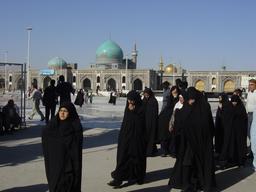
Holy shrine
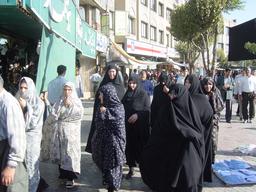
Ladies in Black
We enter Iran from Turkmenistan and experience for the last time the rigorous Turkmenian state officials and the forever-grinning face of the president Turkmenbashi on a large poster. After two hours all the formalities are settled. Our land cruiser has been searched for carpets and other forbidden export goods so that we may finally leave the country. On the Iranian side customs goes faster; the officers are friendlier and the whole process is less complicated. No time-consuming customs clearance and search through our vehicle and equipment. For Ute dress regulations will be stricter in the next four weeks: In Iran women, even tourists, are regulated to wear a headscarf and a long-sleeved coat.
Our first destination in Iran is the strictly religious city of Mashhad, located near the border and place of pilgrimage for Shiite Moslems. Ladies in black inundate the city while the men dress in a casual western style. The "power of Islam" can be felt wherever we go. In the holy district of Imam Reza, Ute is obliged to wear the black chador. The religious police at the entrance are there to check the dress code and find after a meticulous search that Ute' s ankle socks under (!) the long skirt are too short. So Ute must put on black knee socks. Now nothing can be seen except her face and hands. At 40 degrees Celsius in the shade, this is certainly not a pleasure.
 Holy shrine |
 Ladies in Black |
We leave Mashhad after three days and drive on modern, sign-posted roads through stony deserts, steppes, rough plateaus and mountains heading south. These roads were used as trading routes 1,000 years ago but then it didn' t have an asphalt surface and transportation means were camels. Dilapidated cities and caravansaries on the roadside are evidence of this era.
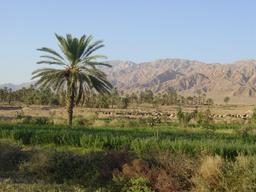 Mountains near Tabas |
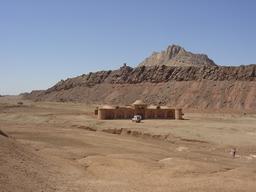 Caravansary near Tabas |
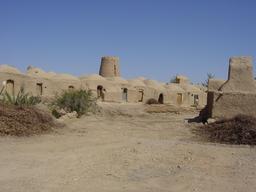 Desert village |
We stay at the green oasis of Tabas and enjoy our picnic at a beautiful park as many Iranians do. It's Friday and many Iranians use their day off to take a trip to the outskirts. We feel as if we were sitting in the Tiergarten in Berlin. We fill our canisters for our continuing journey from a very ancient, underground reservoir still in use today. Despite the dry, hot desert surrounding us, the water is pleasantly cool since it flows - as we've already seen in the Chinese city of Turfan - through a many-kilometers-long underground canal system originating in the mountains.
 Picnic in the park |
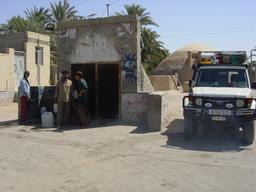 Getting water |
After three days we arrive at the Kerman Oasis. It feels pleasantly refreshing due to its location at an altitude of 1,700 meters. The tourist attractions of Kerman are located very close to each other so we can reach them easily from the central, six kilometer long domed bazaar. After visiting the Friday mosque, a school of the Koran and the bathhouse, we enter the bazaar's teahouse constructed in the traditional Iranian brickwork style.
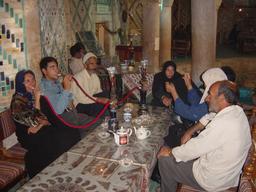 Tea house in Kerman |
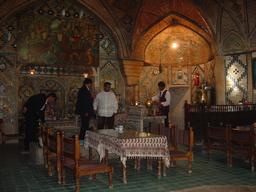 Tea house in Kerman |
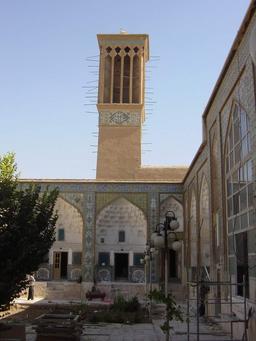 Wind tower near Kerman |
During a cup of tea we converse with Jalal who has lived in Germany for a few years. He gives us a lot of background information in German. We are impressed. Spontaneously we decide to stay another day and move into his small, comfortable guesthouse. Jalal even has a special permit for satellite TV that is actually forbidden in Iran. We spend almost the entire night watching the German news and other German TV programs. The next morning we set out for a hike in the Kerman Mountains. First we follow a lush green river valley in which walnut, juniper, pistachio trees and various herbs grow. Everywhere we smell the fragrance of wild peppermint. At the valley's end the trail changes into an alpine-like trail and we take a refreshing shower under a waterfall.
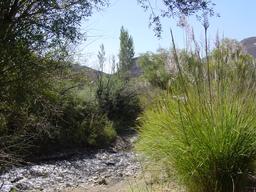 Hiking in Kerman |
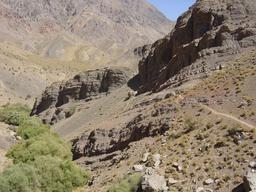 Hiking in Kerman |
Together with Jalal we meet the tourism head of the Province of Kerman who receives us warmly. We discuss the pros and cons of tourism in Iran and exchange views. Equipped with a very informative Kerman travel guide and an invitation to a four-star hotel in Bam paid for by the Iranian government we say good-bye but not without an obligatory photo as memento.
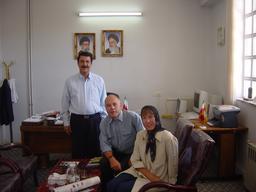 Meeting the tourism head |
The palm oasis of Bam is located in the southern part of the sand desert Dascht-e Lut. In the past it was an important trading and supply point for the caravans. Today old Bam is like a ghost town with the Arc-e Bam, the citadel, the clay-colored dome and rooftops. We walk through narrow alleyways and the former bazaar and try to imagine how life was 700 years ago.
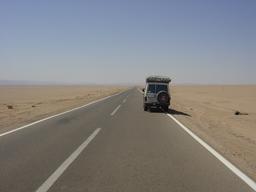 Driving through Dascht-e Lut |
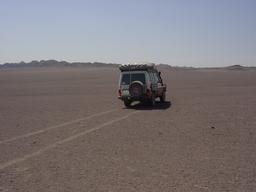 Red Desert near Bam |
 Arc-e Bam |
Early next morning we drive through the desert to a 700-year old crumbling caravansary. A few families still live here in catacombs and make their living from their date palms. At $80 US a palm tree, selling 400 trees brings modest wealth.
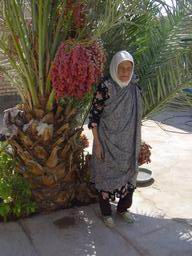 Date palms |
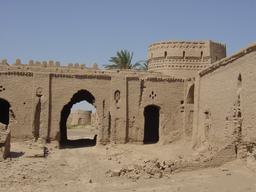 Caravansary near Bam |
Back in Bam we buy provisions and diesel fuel as we plan to drive over the Iranian plateau and across the mountains westward to reach Meymand where we see 12,000 (!) year old cave dwellings, some of which are still in use today. The village is one of the world's oldest settlements. Not too many tourists have yet discovered this interesting place!
 Meymand |
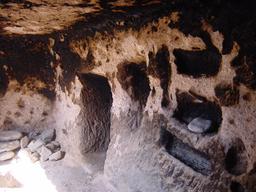 Living in a cave |
 Direction Quader Abdad |
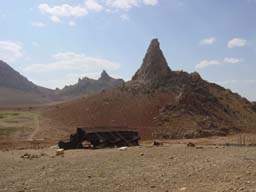 Nomads |
We are awed by the mountainous scenery and set up camp at a small river. While enjoying the evening at the campfire, we suddenly see two gleaming animal eyes - a curious wolf has come close to our camp, standing at a distance of only ten meters, and is frightened away by the beam of our flashlights. Fortunately it wasn' t one of the leopards living in this region.
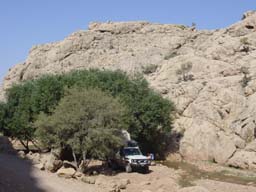 Camping at 2,700 meters high |
 A wolf close by |
After crossing the mountains we arrive in the region called Fars. It was here 2,600 years ago that the Achaemenid Empire was able to expand from India to Greece via Mesopotamia, Egypt and the Near East.
In Naqsch-e Rustam we first visit the rock tombs of the four Achaemenid kings (Darius I and II, Artaxerxes I and Xerxes) whose crypts were chiseled into the rock face in the form of a huge, 23-meter-high cross. Only a small hole leads to the respective tomb, which is unfortunately not accessible to visitors. In front of these impressive rock tombs one can admire the Fire Temple (Zarathustra' s cube of fire). Zarathustra's doctrine represented the state religion during the Achaemenid era, which worshipped the eternal, holy fire. Even today there are still about 100,000 members of this cult in Iran.
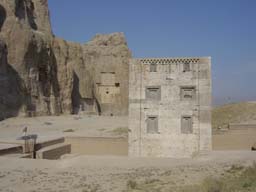 Fire Temple and rock tombs |
Located only a few kilometers away from the rock tombs is the Achaemenid capital of Persepolis: first rediscovered in1928 during archeological excavations. The capital was in its prime from the 6th to the 4th century B.C. In the year 330 B.C. Alexander the Great took revenge for the destruction of the Acropolis in Athens 200 years earlier by the Achaemenid king Xerxes I and practically razed Persepolis to the ground. We try to imagine how life was on the staircases, in the palaces and in the throne room.
 Palace of Darius |
After having seen so much culture we enjoy the green city of Shiraz tempting us to stay and relax in the many local teahouses and gardens. As in so many Iranian cities the colorful bazaar is the epicenter of public life. Here you can go shopping, hear news, meet friends and relax in the tea or bath house - in short: live your life in peace, watch others, relax.
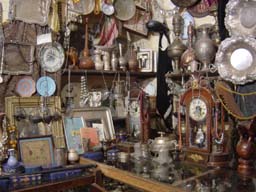 Bazaar in Shiraz |
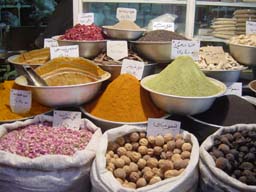 Bazaar in Shiraz |
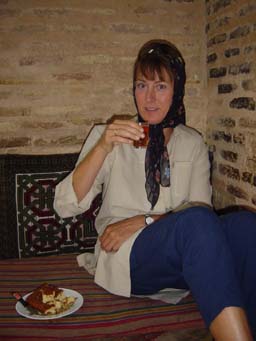 Relaxing in the teahouse |
 Shiraz |
 The Margon Waterfalls |
 The camp at Margon |
The continuing distance to Semirom electrifies us with its diverse scenery that invites you to set up camp.
 Camping at the Zagros Mountains |
Again and again we try to cross the mountain ridge without success. Our map is not good and even the GPS system shows no reasonable way over. Asking the villagers turns out to be complicated, so that we have to drive around the mountain in order to get to the desert town of Yazd. Shortly before Yazd while searching for a place to camp for the night we find a very beautiful canyon in a valley that leads us to spontaneously plan a hike for the next day.
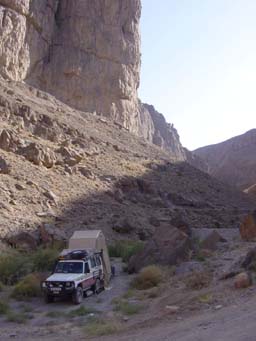 Camping at Taft |
 Hiking near Taft |
In its day Yazd was an important trade and caravan base on the Silk Road between Central Asia and the Near East. Even today much remains of its old significance. The old inner town has the effect of a living museum with its crooked alleyways and clay houses and everywhere on the roofs of the houses are wind towers - an extremely good energy-saving variation of today' s air conditioning units.
 The old inner town of Yazd |
The 350 kilometers until Isfahan go past quickly on the well-built road. Generally all roads in Iran, even the side streets, are of exceptional quality. Together with the fuel prices of about two euro a tank, Iran can be described as evidently car-travel friendly. We' ve heard about the obligatory countervailing duty for foreigners to compensate for the low fuel prices, but we were able to get around paying for it somehow upon our entry into the country.
We feel very comfortable in this extraordinary green city of Isfahan. The only difficulty that we have whenever we come into cities is to find an appropriate and secure place to park our vehicle. Simple hotels have either no parking lot or the entrance is too low. Hotels in the four star category we couldn' t and wouldn' t pay for, so that we sometimes spend a few hours searching for appropriate and affordable accommodations.
The many historical bridges over the Zayandeh Rud (the eternal river) have arcades and built-in, very comfortable teahouses. But also the Meidan-e Imam (huge open square) with the adjacent mosques, the column pavilion and the roofed bazaar must be seen. Only the entrance fees for these tourist sites would have ruined our travel budget. These are more for the well-heeled paying tourist. We then save ourselves the sightseeing tours of the mosques and architecture since we found in our extensive cultural sightseeing up until now a reduced interest for the very similar Islamic monuments. After about ten mosques in various regions we find we' ve been „mosqued-out.„
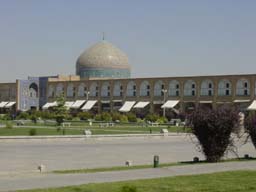 Meidan-e Imam Square |
 Column pavilion on Meidan-e Imam |
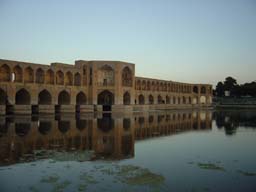 Bridge in Isfahan |
In Tehran we plunge into the chaotic traffic. Many travelers had warned us. In fact the traffic in Tehran is the most chaotic that we have ever yet experienced. The city has grown a bit too fast with 10 million inhabitants. There is hardly a traffic light or similar insignia of orderly road traffic regulations. Whatever - you have to make the best of what you' ve got. At second glance most traffic participants are very considerate, look ahead and react fast. Collectively everyone distinctly trusts the cordiality of the other. A huge mistake would be to insist on the law as is done in Europe. We choose to settle all our many errands by taxi, the most important being our laptop, which has had a faulty hard disk since Tibet. Computer down times were initially limited, but since Iran working by computer has hardly been possible. Michael Martin, a known photographer and travel journalist who jumped in as courier for a new hard disk, heard our SOS call over the Internet. We had already met Michael in Tibet and made a date to meet in Tehran to talk about our experiences in Turkmenistan. We were able to secure our data at a computer center and install the new hard disk. A re-installation of all the programs however took much of our precious time.
We have less luck with our satellite telephone. The Thuraya repair shop confirmed that the almost new telephone had a hardware defect. Without spare parts we can' t get any help and they don' t want to give us a replacement telephone (of the same value). The German importer can' t help us either unfortunately. Hot tip: You should take two satellite telephones with you when you' re making this kind of journey.
While shopping in Tehran a few things come to mind. The shops and boutiques are modern and styled as those in the west. We ask ourselves, just where are all these cloaked women going to wear all these revealing clothes? In the men' s shops you won' t find a tie, as these have been banned since the Islamic revolution as a western, decadent piece of clothing. In the buses the men and women are separated. The men sit in the front of the bus and the women in the back. Sometimes there is a separating grid to protect the population from a prohibited intermingling.
We are happy to leave Tehran after three days and set out for the Caspian See. Unfortunately we leave on an Iranian long weekend and sit bumper to bumper for over 150 kilometers on an otherwise very beautiful pass (2,700 meters). At the Caspian See we are surprised by our first continuous rain, that waters down our beach mood somewhat. To get out of the rain we drive in the direction of Azerbaijan and turn to the west to a very green, subtropical-like mountain.
 Continuous rain |
In the mountains we arrive at the beautifully situated mountain village of Masuleh. Because of the steepness the houses are built on terraces built on the roofs of the houses below. The atmosphere at this place is very primitive and tranquil. Our last place to visit is Masule, a wonderful conclusion to our four-week tour throughout Iran. Unfortunately, our visas are running out and we have to leave the country within the next two days.
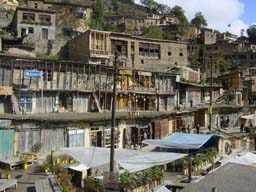 Masuleh |
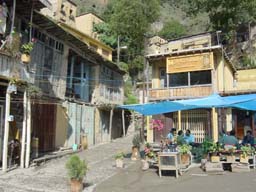 Masuleh |
Where we will next travel will be decided after this copy has gone online. We hope to continue the main route of the Silk Road through Iraq. In Tehran we have applied for a transit visa at the Embassy of Iraq, but the issuance is still questionable. If we don' t get the visa we will drive to Turkey and then on to Syria.
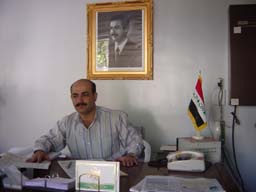 Iraqi embassy |
Admittedly it wasn't easy for Ute as a Western European woman to fit into her new role in a strict Islamic society. The headscarf and the long cloak were not very comfortable and a bit too hot at temperatures around 40 degrees Celsius. However more intensive was the experience we made when meeting with men in this Islamic man' s world. Ute was simply ignored. It was in the little details in everyday life where she got a true feeling of the roles of men and women in Iranian society. During conversations, questions relating to Ute were always addressed to Andreas, and while shopping change was always given to him instead of back to her. Even so, the Iranian women seemed in spite of their living circumstances to a large extent more educated and more willing to help than the men: it was easier and more effective to ask a woman for help. Maybe the women are developing a new awareness to contrast the traditional-male world; hopefully it will leave its mark on society in the near future.
We have, of course, also contemplated the country's politics and have tried to get a feel for public opinion by conversing with the people. We found that Iranians are of the opinion that the roots for the Islamic Revolution can also be found in our Western world. The Shah was encouraged to endeavor a change, too quickly, to western lifestyle-oriented values. This rapid development was too much for the population and excluded especially the poor people living in the countryside. This created a breeding ground for an Islamic State of God together with its well-known reactions.
Another strong influence coming from the Western world was exerted during the Iran / Iraq war. Of course the people haven' t forgotten that the two great powers, the United States and the Soviet Union, supported Saddam Hussein ideally and materially (as well as with know-how regarding the nowadays often-cited weapons of mass destruction) during the attack on Iran, which caused hundreds of thousands of victims and led to enormous destruction. It is no wonder that even today the Iranians have nothing good to say about the Americans.
Many Iranians see the reforms and the moderate course of their president Hatami as a chance to improve relations between the western world and Iran. A distant goal could be a new „separation of powers„ between Church and State. What the people do not at all accept are the criticisms of their „corrupt government„ or the „axis of evil.„
While traveling through the country we were frequently asked if we are American or British citizens. After telling the people that we were German, we were met by a wave of affection. This feeling made traveling in Iran very easy and pleasant to us.
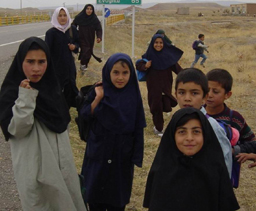 Merci Iran |